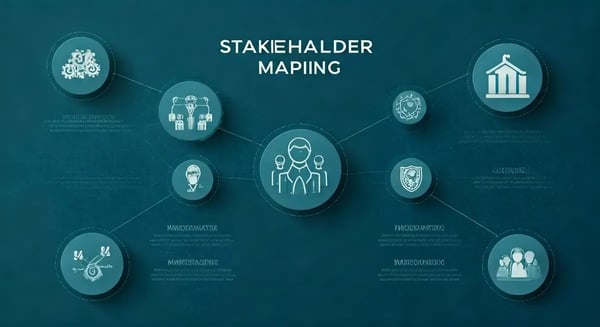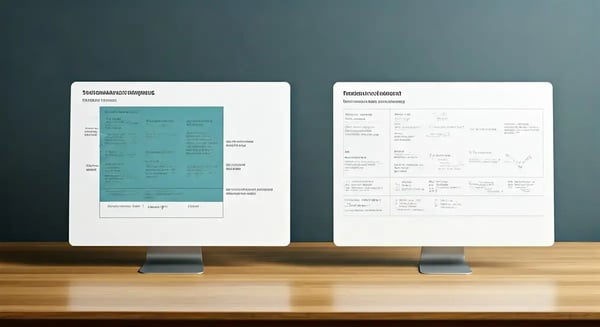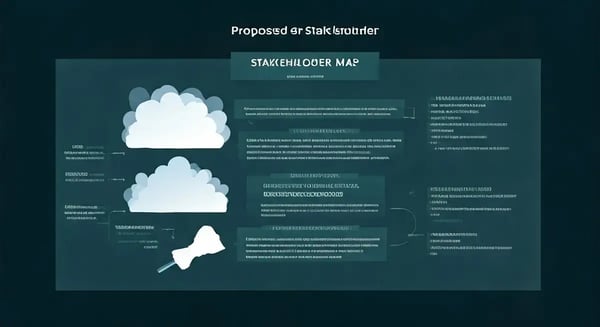Why a proposed stakeholder map is better than the conventional one?
Key Highlights
- Stakeholder mapping process is a cornerstone of project management, enabling businesses to categorically map both internal and external stakeholders based on their impact and vested interest.
- A proposed stakeholder map introduces advanced techniques, offering greater insights and strategic benefits compared to conventional models.
- Identifying and prioritizing key players allows project teams to optimise engagement strategies for maximum project success.
- The proposed model enhances effective communication, enabling tailored engagement plans for different stakeholder groups.
- Comparative analysis reveals the superior capabilities of modern mapping methods in addressing the limitations of traditional stakeholder mapping techniques
Introduction
Stakeholder mapping is key to driving project success and helping build good stakeholder relationships. In the stakeholder mapping process, you look at both internal stakeholders and external ones. These people have different levels of influence and interest in the project. When you use a new framework, it can improve business results by making engagement strategies better. It also helps make sure the team meets stakeholder expectations.
A proposed stakeholder map does better than older models. It helps solve challenges in the mapping process and makes outcomes better. So, why is this new approach so important? Let’s look at how stakeholder mapping is changing and what it can do now.
Understanding Stakeholder Mapping

Stakeholder mapping is where planning and strong engagement meet. It helps businesses see and sort potential stakeholders by their influence, interest, and impact on a project or on the organisation.
But the mapping process is not fixed. It needs to be flexible and open to change. To keep up with the business world, the process should bring new ideas and be able to adjust. When groups look at both old and new stakeholder mapping techniques, they put themselves in a good place. They can better see stakeholder relationships, use the right engagement strategies, and spot potential risks before they happen.
Definition and Overview of Stakeholder Mapping
Stakeholder mapping is a way to show, in a picture, how stakeholder relationships work in a project. It puts the stakeholder relationships, and their power, interest, and influence of various stakeholders on clear axes. This makes it clear who will have an important role to play in the project.
The stakeholder mapping process helps the team make a list of potential stakeholders. It puts them in groups you can act on. When you look at the visual representation, you can plan engagement strategies. The team can see the positions of the various stakeholders and how the stakeholder relationships work.
Mapping like this is key if you want a successful project. It means you notice the relevant stakeholders and bring them into the process. Everyone who should be, will be asked and kept in the loop. If you skip the mapping process, you might miss out on people or groups who could help. These potential stakeholders or outside people could be what the project needs to go well. The visual representation of the stakeholders helps the project manager see the bigger picture and set expectations. The goal is to keep planning aimed at good outcomes.
Evolution of Stakeholder Mapping Over Time
The stakeholder mapping techniques have changed a lot over the years. Before, people used simple labels. Now, these methods look at many things at the same time. In the past, people used historical data mainly to find potential risks. They did not really check how involved each person or group was.
The old way of doing the mapping process used easy frameworks. These often did not look at how things like society, culture, and new technology be changing. Over time, better tools gave more about what people feel and how both groups and individuals act. This helps us now understand stakeholder engagement better.
These days, stakeholder mapping is based on better ways of sorting people, using stakeholder mapping methods from many areas. There is also a mix of this process with online tools. This change has shown that it is important to have correct, up-to-date models. They need to fit well with what stakeholder expectations are, and be ready to change if new things come up in regulatory agencies, project teams, or with outside groups.
Importance of Stakeholder Mapping in Modern Business

Stakeholder mapping gives the base businesses need to handle different stakeholder groups in the right way. When you use the right way to sort these groups, it helps the business to put time and money in the best place. You can talk with key stakeholders, handle potential risks, and get the best results.
With better methods, organizations can solve worries these people have. At the same time, you build a good relationship that helps the project's success and the big goals you have. Stakeholder mapping also lets you set up better ways to talk and make long plans that keep people interested. This can help you get more done, no matter what kind of work you do.
Enhancing Stakeholder Engagement
An effective stakeholder engagement strategy is important for any business that wants to build good connections. When you map out stakeholder groups by looking at their level of interest and how much influence they have, your team can make better plans to meet each group's needs.
Talking with your stakeholders at the right time and following a clear communication plan helps stop confusion. It lets you do effective communication about your goals. This makes people feel like they matter and keeps them a part of your project, which is important for getting things done on time.
A strong stakeholder engagement strategy also helps solve problems with sharing information. It makes teamwork easier between regulatory agencies, internal teams, and other stakeholder groups. When everyone works together better, there will be less trouble, and your project gets done faster and more smoothly.
Improving Project Outcomes
The link between stakeholder mapping techniques and better project outcomes is strong. When you do good stakeholder mapping, you make sure people’s needs are met. This cuts down on pushback and brings everyone’s interests together with the main goals of the project.
If you focus on stakeholder engagement the right way, you build a strong way to reach the outcome of the project fast. Working with input from key stakeholders helps you avoid surprises later. It also lets you use good feedback that can lead you to find better and new solutions.
In today’s world of project management, it is important to do stakeholder mapping. When you know stakeholder expectations, you make it easier to move ahead and reach project success. Bringing this approach into your work can turn tough moments into chances to do something good and make sure the project keeps moving forward from start to finish.
Driving Business Strategy and Decision-Making
Stakeholder mapping is now seen as a key part of coming up with strong business strategies and making important decisions. When you look at the interests, attitudes, and power of each group, it helps decision-makers see things more clearly. This way, project plans can match up better with business goals.
A clear decision-making process that uses what we learn from stakeholders helps companies deal with concerns before they turn into bigger issues. As a result, people are more likely to support company ideas and plans. This approach also helps guide where to put resources, how and when to work with partners, and how to connect with the local community.
Understanding stakeholder expectations with modern mapping methods lets companies change their strategies when they need to. It helps the business grow in a complete way and gives it an edge that lasts, even in different markets.
Stakeholder mapping is the foundation for smart business moves both now and in the future.
Traditional vs. Proposed Stakeholder Mapping Models

Comparing old ways with the new stakeholder mapping models shows there have been big steps forward in stakeholder engagement. Before, people used tools like the interest matrix, but these did not be very good at seeing how stakeholder sentiment or willingness to change could shift over time.
The new mapping models, by using more deep insights, help make a much more clear engagement plan. These plans look at each individual stakeholder in detail. The new models can show how stakeholders move and change, letting project teams track this with no trouble. Because of this, the newer stakeholder mapping models are better at seeing risks coming and help a lot more with making sure plans line up with the success of the project.
Limitations of Traditional Stakeholder Maps
Even though many people use them, the usual ways of mapping stakeholders have some big problems. For example, when you look at high influence and low interest groups by using a simple interest matrix, you do not see the real mix of issues that come up today.
When you call someone “low interest,” you can miss that their needs might change if the project changes. This can lead you to overlook some big relationships. Old mapping tools can not keep up when feelings and levels of interest go up or down over time.
Because of all this, many companies find it hard to put in place effective communication with what stakeholders really want. To fix that, some new solutions use bigger, more flexible systems that can change as time goes on. This makes sure you keep up with everyone and use a better way that fits the world now.
Key Features of Proposed Stakeholder Maps
Modern proposed maps stand out because they let you easily change things the way you want. They sort groups by things you can measure, like communication plans, how much someone can influence, and who has interest in what. This helps make sure that each plan to connect with people meets their needs.
Another good thing is the strong visual view you get. You can see detailed dashboards that show how different people or groups are linked. It is easy to track how you are doing or to look at your plans again. This helps figure out what work to put first in your engagement models.
These modern maps also mix in tools that look at people’s feelings and views. They give real reports and ways to sort jobs that change how effective stakeholder management is done. With automation, you get more accurate results. This is much better than old models, which use out-of-date details.
Comparative Analysis: Benefits of Modern Approaches
Using modern stakeholder mapping methods brings many benefits over old models. One of the best things is that they let businesses stay flexible. These methods can respond when people or groups change their opinions or roles. This happens because the new comparative analysis mechanisms show changes in how people feel and what they do.
Now, companies can work with different types of information at the same time. This might include how much power someone has, their position, or if they are important for the business. All this gives people who make choices the tools they need to avoid troubles in a simple way. By changing stakeholder engagement strategies with what’s happening right now, you get better results than sticking to old styles that do not change.
With these modern mapping designs, every part of engagement stays updated as things change. Teams can work together better. This makes these new ways much more popular than the old, firm ways— and they keep winning in the business world because of it.
Detailed Breakdown of a Proposed Stakeholder Map

A proposed stakeholder map gives a clear and easy-to-understand visual representation of all the key stakeholders in a project. It shows the levels of power and interest that various stakeholders have. By using this map, you can place stakeholders into groups like high influence, high interest, or low influence. This way, project managers can make engagement strategies that fit each group better.
With an interest matrix or a stakeholder matrix, the mapping process gets even better. It helps you look at stakeholder relationships more closely. You get to know which relevant stakeholders to focus on, what potential risks might come up, and whose interests are strong in the project. By using these tools, project teams can plan how and when to talk to everyone who matters. That means you stay updated and connected with all relevant stakeholders, which is key to project success.
Components of a Proposed Stakeholder Map
A proposed stakeholder map has a few important parts that help it work well. First, you need to find key stakeholders. These can be people from inside or outside the group. This way, you cover all the main people who have an interest in what you do. Next, you place each person or group into a category by looking at their level of influence and interest. For this, many use something like an interest matrix or a stakeholder matrix. This step helps you plan your talks and meetings in the right way.
It is also important to set up good ways to talk to everyone. When you have effective communication, you keep strong stakeholder relationships. You can meet their wants and needs, and you can also change up your engagement activities if needed. When you put these pieces together, you make a strong stakeholder map. This helps you do better in your project, keeps people happy, and moves your work forward.
How to Build a Proposed Stakeholder Map Step-by-Step
Building a stakeholder map takes a few clear steps. First, you need to find the key stakeholders. Look at both groups inside and outside the company. Think about their level of power and interest in what you do.
Then, you use an interest matrix to put these people or groups into the right spots. After this, make a visual representation and plot every stakeholder on an interest grid, which helps you see where they stand.
You should update the stakeholder map often. This keeps it right if there are any changes in your relationship with them or what they expect from you.
Last, make an engagement plan that fits each group. This plan should help you with effective communication and help you spot and handle any potential risks as you go through the project.
Examples of Effective Proposed Stakeholder Maps in Action
Examples of good stakeholder maps show how a plan made for each project can make things better for everyone. In a technology project, using a stakeholder matrix helps to find groups who have a lot of power and care a lot about the work. This way, you can make engagement strategies just for them. In healthcare, maps show not just regulatory agencies, but patient advocacy groups too. This helps to open a dialogue.
For government projects, using an interest grid can point out how internal stakeholders and those from outside work together. It helps managers know what every group wants, and how to meet stakeholder expectations. These mapping methods do more than just show who is involved. They also help reduce potential risks and show why stakeholder engagement is so important.
Implementing Proposed Stakeholder Maps in Various Sectors
Exploring different areas shows how useful stakeholder mapping can be. In technology, using a careful stakeholder mapping process helps with better communication. This means that key players can stay focused on the project goals. In healthcare, these maps help handle many stakeholder groups. They make it easier to plan for the needs of both internal and external stakeholders. Government projects use their own mapping process. This brings attention to the role of regulatory agencies and the effect projects have on the community. Stakeholder mapping not only helps with stakeholder relationships but also makes engagement activities smoother. All of this can lead to greater project success.
Case Study: Technology Industry
A stakeholder map in the technology industry shows the many ways key players connect and how much influence they each have. By using an interest matrix, project teams can spot high-power stakeholders like regulatory agencies and project sponsors. Then, they can make the right engagement strategies for these people. This visual representation helps clear up stakeholder expectations. It also supports effective communication through every part of the project.
When you focus on what both internal and external stakeholders need, it brings people together to work better. This makes it more likely to have a successful project. Using targeted mapping like this shows how important stakeholder engagement is for project success.
Case Study: Healthcare Sector
In the healthcare space, a proposed stakeholder map helps people talk and work together. This map connects patients, providers, and regulatory agencies. Project managers use an interest matrix to see the levels of interest and influence each key stakeholder has. Knowing this lets managers build engagement strategies for all the different groups. This makes the stakeholder mapping process quicker and better, and it helps everyone work as a team. With this, you get a complete engagement plan that boosts the outcome of healthcare projects. The mapping process makes sure your healthcare initiatives do their job in the best way.
Case Study: Government Projects
Government projects can be hard because there are a lot of people and groups involved. With stakeholder mapping, project managers can spot the key players, like regulatory agencies and community groups. A good stakeholder map helps project teams see who is interested in the project and who can make things happen. When they use tools like an interest matrix or stakeholder matrix, they can see how much the people care and how much power they have. This way, they can make better engagement strategies for them.
Getting your message across to both outside people and your own team is very important. It helps keep the project in line with what the public wants. When you use stakeholder mapping right, you are also trying to make sure that everyone is happy with what happens. This makes project success much more likely. To get the results you want, you have to manage your key players and plan your strategies well from the start.
Overcoming Challenges with Proposed Stakeholder Maps

Working with stakeholder mapping can be hard. There is often some pushback from people who do not like new ways to do stakeholder mapping. It is also important to make sure that the map is right and complete. When you plan your stakeholder engagement, you have to think about power and interest for every group. You want to focus on those who have a lot of say in what happens.
Looking at historical data can help you see common problems. This will let project managers make better plans for communication. Good engagement activities matter too. If you keep talking and working with the people involved, you lower risks and increase the success of the project. Keeping up these stakeholder relationships will also give you good lessons that can help with future stakeholder mapping.
Common Pitfalls and How to Avoid Them
If you miss key stakeholders during the stakeholder mapping process, you may create big gaps in your engagement strategies. The project's success depends on knowing that people and groups have different levels of interest and power. If you do not make an interest matrix, your communication plans can go wrong and leave out those with more power. You need to have regular updates and open talks to stop resistance and prevent problems. One way to avoid these issues is to use a solid stakeholder mapping method that uses historical data and feedback. This gives you a clear visual representation of stakeholder relationships and helps the project have a better outcome.
Addressing Resistance to New Mapping Techniques
Resistance to new stakeholder mapping techniques often comes from not understanding them or being afraid of change in the project teams. To fix this, you need to use effective communication and talk about the benefits. These benefits include better engagement and easier management of project stakeholders. It helps to give training and show why things like an interest matrix or stakeholder matrix are good. This can take away fear and worry. Getting key players involved early also helps. It makes sure their needs are included, helps create a team atmosphere, and helps people accept the process. This leads to better stakeholder relationships through stakeholder mapping.
Ensuring Accuracy and Completeness in Mapping
Having accuracy and making sure your stakeholder mapping is complete are key to a successful project. It is important to keep the stakeholder matrix up to date. You need to add new and relevant stakeholders as the project moves forward. Try to have effective communication with both internal and external stakeholders. This can help you know their levels of interest and influence in the project.
You can get a better idea about stakeholder expectations by using historical data from past projects. When you create an engagement plan, be sure to think about any potential risks. Pay close attention to the needs and wishes of each group. This will make your mapping process stronger. A good process like this helps your project be more successful in the end.
Measuring the Impact of Improved Stakeholder Mapping
Evaluating how well advanced stakeholder mapping works needs some clear ways to measure stakeholder engagement and project success. Project managers track the levels of interest and how much influence various stakeholders have. This helps them make better engagement strategies. Feedback from meetings and other engagement activities gives historical data about stakeholder relationships. This makes it possible to always work on getting better. There are regular checks on project success. These checks compare results to the main project goals. This helps make sure the stakeholder mapping method is still important and useful. In the end, if there is strong and effective communication, project success gets better. This shows how important good stakeholder relationships are.
Metrics for Success in Stakeholder Engagement
Measuring success in stakeholder engagement means using different ways to check how well things are going based on the project’s goals. One key way is to look at the level of interest and influence that each stakeholder has. You can show this clearly by using an interest matrix. Keeping track of engagement activities like feedback from the project sponsor and how well the communication plan works helps you understand the stakeholder relationships better. Checking historical data from past engagement outcomes also shows what can bring successful project results. Regular checks help improve the stakeholder mapping process. This makes sure everything lines up with the project’s success and also meets stakeholder expectations.
Long-term Benefits of Adopting Advanced Mapping Models
Using advanced mapping models in project management helps everyone better understand stakeholder relationships and how they change. This way, engagement strategies can match stakeholder expectations, making it easier to talk and work with others. If you use a full stakeholder matrix, you get to see who the key players are. This lets you make engagement plans that fit their needs. The visual representation of various stakeholders shows the effect of their influence on the project. This guides the team toward project success. Being proactive about stakeholder mapping lowers potential risks and helps make sure the work keeps going well over time.
Feedback and Continuous Improvement Processes
Building an ongoing feedback loop is important to make stakeholder mapping better. When you engage with both internal and external stakeholders often, you can use tools like surveys, phone calls, and workshops to stay in touch. This helps you get their ideas and insights, which you can add to the mapping process. Talking often with people in this way will help make stakeholder relationships stronger. It also helps your engagement strategies stay in line with what people expect as things change.
Looking at the feedback from stakeholders lets project managers see trends and see the impact of past mapping techniques. Managers can use this to adjust and improve the stakeholder engagement strategy. Making changes as you go can lead to better outcomes and a higher chance that the project will be a success. Using good stakeholder engagement and keeping up with your engagement strategies makes the whole mapping process stronger.
Conclusion
Adding a proposed stakeholder map helps make project management better. It gives a clear visual representation of who the stakeholders are and how they relate to each other. This method makes it easier to see which engagement strategies to use. It also helps with effective communication between all stakeholder groups.
By using the map, the project team can quickly see the different levels of interest and power that each group has. They can then adjust their engagement strategies to keep up with these changes during the project. This lets teams work well with every relevant stakeholder.
In the end, this way of working helps the project do well. It makes sure all the right stakeholders are included and that everyone gets the information they need for the success of the project.
Frequently Asked Questions
What makes a proposed stakeholder map superior to traditional models?
A proposed stakeholder map helps make things clear and keeps people involved. It uses new ways to show how everyone is connected and works together. This lets all the people in the group have their say, instead of missing out. The stakeholder map is not like old models because it focuses on how people talk and work with each other over time. This way, the group can make better choices, and it helps the project do well. A good stakeholder map is key for a successful project.
How often should stakeholder maps be updated?
Stakeholder maps need to be kept up to date on a regular basis. It is good to update them every 6 to 12 months, or when there are big changes in the project or organization. This helps be sure the information in the map is good and still reflects how people are connected and who has influence. When these maps are kept current, it is easier to make good choices and use stronger engagement strategies.
Can small businesses benefit from advanced stakeholder mapping?
Absolutely! Advanced stakeholder mapping helps small businesses in many ways. It makes it easier to talk with people who matter to the company. It also helps you make better choices because you know who is important for the work. By finding the key people, you can put your time and energy where it will help the most. This way, you use resources well. It also helps people work together, which is good for the whole team. In the end, using stakeholder mapping gives you a better chance to grow and stand out from other businesses in the market.
What are the first steps in transitioning to a proposed stakeholder map?
To start moving to a new stakeholder map, first pick out the key stakeholders and what they care about. Then, get any information you have right now about how people or groups work together and how much say they have. Last, have talks with everyone so you can agree on what is most important to each person. This will help to make sure all people know about and support the new way you build the stakeholder map.
You May Also Like
These Related Stories

Business Analysts : The Business Accelerator of the Organization

BABoK Terms That Confuse Us The Most



No Comments Yet
Let us know what you think